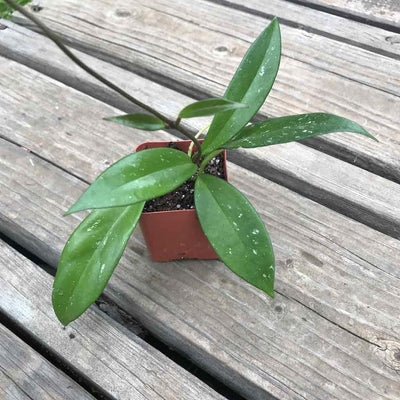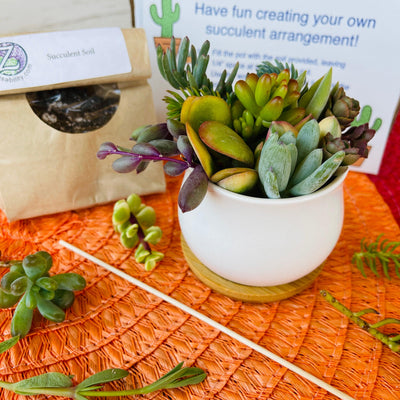The Most Important Succulent Care Tips
What's a Succulent Plant?

A succulent plant is any plant that has thick engorged parts that retain water. These parts that hold extra water are usually the stem or leaves, but can also be the roots. It is this ability of succulents to retain water that make them easy-care in comparison to other houseplants and garden plants.
Succulents Are Drought-Tolerant, Making Them Great Beginner Plants
Since succulents retain water, they can go a lot longer between watering than tropical house plants, which often require the soil to stay damp or moist. In fact, with succulents, you WANT the soil to dry out completely before you water again. Overwatering is the most dangerous thing to succulent plants.
Succulents often grow in naturally dry climates, such as deserts. This is especially true for Cactus, Aloe, and Agave plants. These plants have shallow root systems because it doesn't rain enough in their natural environment for the soil to get soaked. Since all the damp soil is near the surface, succulents only need to have their roots reach down long enough to drink from the damp soil and anchor them down.
Type of Succulents
Succulent species are found in many different plant families. There are a few

plant families that are made up almost entirely of succulents, such as the Aizoaceae, Cactaceae, and Crassulaceae plant families.
There are 'soft succulents' such as Echeveria, Sedeveria, Graptoveria, and others that form rosette shapes as they grow and are best in partial sun. Aloe, Agave and Cactus tend to be full-sun succulents. There are thousands of different types of succulents making this a hobby with endless potential for learning about new plants.
Yes! Succulents Need Water
Even though succulents retain a lot of water and grow naturally in dry climates, these live plants still need to be watered. Misting them is not enough. They will want a good drink once the soil in the pot is completely dry. For many succulents, you don't need to water them until they are really thirsty and the leaves start to look deflated or slightly wrinkled - like raisins.
- When you water a thirsty succulent, you will see it plump right back up and look happy again within a day or two.
- On the other hand, if you water an already plump and recently watered succulent, you risk the roots sitting in soggy soil. Overwatering succulents in this way can easily lead to root rot.
For more detailed info on watering succulents, see this post.
Succulents Need To Be in Well-Draining Soil
To avoid root rot, succulents should be planted in a well-draining soil. We recommend Kellog's Citrus, Palm & Cactus Soil as a good succulent soil out-of-the-bag. If you don't have access to this soil, then you can make your own mix by adding perlite or pumice to potting soil. These additives help to aerate the soil and increase the drainage.
How to Mix Your Own Succulent Soil
A good ratio of soil to additive is 2 parts soil to 1 part additive. You may need to adjust this ratio for your climate. We are in a high desert, Mediterranean climate with low humidity in the summer months.

Size of the Pot Matters
If you have a baby plant is a small pot, such as a 2' pot, then the soil will dry faster and it is less likely the roots will sit in soggy soil. In this case, you could use more potting soil, such as 3 parts soil to 1 part additive. This will help you from having to water too often. The rule of thumb still applies: wait until the soil is completely dry to the touch before watering again.
Pot Your Plants in the Right Pots
You do want to make sure that you don't 'overpot' your succulents. This means putting a plant in too large of a pot. The reason this can be a problem is that the soil stays wet longer and if the plant only has small roots, it will be sitting in wet soil for too long. You can plant a few smaller plants together in a larger pot and then there will be more roots to drink up the water.
Terra Cotta Planter Pots vs. Ceramic Planter Pots
Terra cotta is a breathable clay. This makes these types of planter pots ideal for succulents. On the other hand, ceramic pots are usually glazed, which prevents any airflow. This means the soil in ceramic pots will stay damp longer than in a terra cotta pot. Ceramic pots are great to use and can really add some flare to your arrangements and gardens.
Just take extra caution not to overwater when planting in ceramic pots. If you are using a ceramic pot, we recommend inserting a chop stick into the soil to check dampness and not watering until it comes out dry.
No Rocks At the Bottom of Your Pots
It's a common misconception that adding a layer of rocks to the bottom of a pot helps to keep soil from falling out the hole and increase drainage. In reality, rocks in the pot help the water pool at the bottom of the pot, which is the opposite of what you want when growing succulents.
Do Succulents Need Sunlight or Can I Grow Them Indoors?
Most succulents need some direct light and ideally this is sunlight. This direct light can be provided by a window or grow lights. There are a few succulents that have a tolerance for low light conditions and most of these are snake plants and Haworthia.
In addition, most of the hanging, crawling 'string' succulents like lots of bright indirect light but don’t necessarily need direct sun or indoor lights. These include tring of Pearls, String of Dolphins, String of Hearts, String of Fishhooks, etc.










Leave a comment